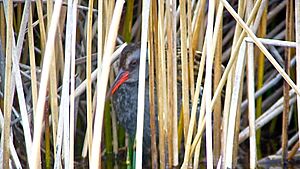Austral rail facts for kids
Quick facts for kids Austral rail |
|
|---|---|
 |
|
| Conservation status | |
| Scientific classification | |
| Genus: |
Rallus
|
| Species: |
antarcticus
|
 |
|
The austral rail (Rallus antarcticus) is a small bird that belongs to the rail family, which includes rails, gallinules, and coots. It is considered a Vulnerable species, meaning it faces a high risk of extinction in the wild. You can find this bird in parts of Argentina and Chile.
Contents
About the Austral Rail
The austral rail is a unique bird. Some people once thought it was the same species as the Virginia rail, but most scientists now agree they are different. This bird is the only one of its kind, meaning it doesn't have any subspecies.
What Does It Look Like?
The austral rail is about 20 centimeters (8 inches) long. Adult birds have dull brown feathers on their backs, with black centers and buff (light yellowish-brown) edges. Their face and throat are gray, and their chest is olive brown. The sides of their body have cool black and white stripes. Young austral rails look similar to adults, but their chest feathers have sooty (dark) tips, and their throat is white.
Where Does It Live?
The austral rail lives in specific areas in southern Chile, especially the Magallanes Region, and in southern Argentina, between the Río Negro and Santa Cruz areas. It used to live further north, in places like Santiago, Chile, and Buenos Aires, Argentina. Sometimes, a few birds have even been seen far away on the Falkland Islands. These birds prefer to live near the coast in wet fields, grassy meadows, and areas with reeds and rushes near lake shores.
How Does It Behave?
Moving Around
Some austral rails that live in the very south of their range might move north when autumn arrives. This helps them find warmer places or more food during the colder months.
What Does It Eat?
Scientists don't know much about what the austral rail eats or how it finds its food. However, they think it might eat similar things to the Ecuadorian rail. That bird eats a wide variety of foods, so the austral rail probably does too!
Raising a Family
We know very little about how austral rails raise their young. They seem to lay eggs in October and November in Chile, and in November in Argentina. One possible nest was found on the ground under a bramble bush. It was a small dip in the ground lined with grass and rushes, and it held eight eggs.
What Does It Sound Like?
The main sound the austral rail makes is a series of high-pitched notes like "pee," "peeree," or "peek." They often sing these calls together in a duet. They can also make low booming sounds, grunts, or a long, drawn-out squeal.
Why Is It Vulnerable?
The IUCN (International Union for Conservation of Nature) has changed its assessment of the austral rail's status over the years. It was first listed as Threatened in 1988, then Critically Endangered in 1994, and since 2000, it has been listed as Vulnerable. This means its population is decreasing.
For a long time, between 1959 and 1998, there were no confirmed sightings of this bird! Now, we know it exists in only a few places. Experts estimate there are between 2,500 and 10,000 adult birds, but the number could be as low as 1,000.
The biggest threat to the austral rail is grazing animals in its habitat. This means animals like cattle or sheep eat the plants where the rails live and hide. Other problems include changes to water flow and the presence of introduced American mink (Neogale vison), which are predators. Luckily, the austral rail lives in five protected areas and some private lands that are also protected.
Images for kids




